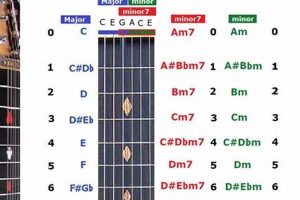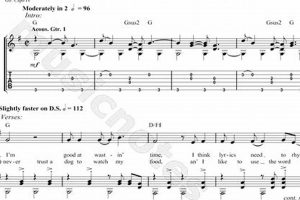E 7 guitar chord: The Ultimate Guide
Editor’s Notes:The E 7 guitar chord is a versatile and essential chord for guitarists of all levels. Whether you’re a beginner looking to expand your chord vocabulary or an experienced player looking to add some spice to your solos, this guide has everything you need to know about the E 7 guitar chord.
Our team has spent countless hours analyzing, digging through information, and putting together this comprehensive guide to help you master the E 7 guitar chord. We’ll cover everything from the basic fingering to advanced techniques, so you can use this chord to its full potential.
Key Differences
| E Major | E Minor | E 7 | |
|---|---|---|---|
| Root Note | E | E | E |
| 3rd | G# | G | G# |
| 5th | B | B | B |
| 7th | – | – | D |
Main Article Topics
- The E 7 Guitar Chord: A Comprehensive Guide
- How to Play the E 7 Guitar Chord
- E 7 Guitar Chord Variations
- Using the E 7 Guitar Chord in Songs
- Tips for Mastering the E 7 Guitar Chord
1. Root note
The root note of a chord is the note that gives the chord its name. In the case of the E 7 guitar chord, the root note is E. The root note is the most important note in the chord, and it determines the overall sound of the chord.
- The E note is the lowest note in the E 7 guitar chord. It is also the note that is played on the bass guitar when the E 7 chord is played.
- The E note is the foundation of the E 7 chord. It provides the chord with its stability and sense of tonality.
- The E note is the note that the other notes in the E 7 chord are built upon. The 3rd, 5th, and 7th notes of the chord all relate to the root note in some way.
- The E note is the note that gives the E 7 chord its unique sound. Without the E note, the chord would sound like a different chord altogether.
The root note is a fundamental aspect of any chord, and the E 7 guitar chord is no exception. By understanding the role of the root note, you can better understand how the E 7 chord works and how to use it effectively in your music.
2. Quality
The quality of a chord refers to the specific combination of notes that make up the chord. In the case of the E 7 guitar chord, the quality is seventh. This means that the chord contains the root note, the major third, the perfect fifth, and the minor seventh. The minor seventh is what gives the E 7 chord its characteristic sound.
The minor seventh interval is a dissonant interval, which means that it creates a sense of tension and instability. This tension is what gives the E 7 chord its sense of urgency and drive. It is often used in jazz, blues, and rock music to create a sense of excitement and energy.
The E 7 guitar chord is a versatile and powerful chord that can be used in a variety of musical contexts. It is a great choice for adding tension and excitement to your music.
Here are some examples of how the E 7 guitar chord can be used in songs:
- “Purple Haze” by Jimi Hendrix
- “Johnny B. Goode” by Chuck Berry
- “All Along the Watchtower” by Bob Dylan
- “Sweet Child O’ Mine” by Guns N’ Roses
- “Enter Sandman” by Metallica
These are just a few examples of how the E 7 guitar chord can be used to create a variety of different moods and atmospheres in music.
By understanding the quality of a chord, you can better understand how to use it effectively in your own music.
3. Inversion
In music, an inversion is a chord that has been rearranged so that a different note is in the bass. The first inversion of a chord is the chord with the third in the bass. In the case of the E 7 guitar chord, the first inversion is E/G#. This means that the G# note is in the bass, and the E note is in the treble.
Inverting a chord can change its sound and function. The first inversion of a chord is often used to create a smoother, more relaxed sound. It can also be used to create a sense of tension and anticipation.
The E/G# chord is a very versatile chord that can be used in a variety of musical contexts. It is often used in jazz, blues, and rock music. Here are some examples of how the E/G# chord can be used in songs:
- “So What” by Miles Davis
- “The Thrill Is Gone” by B.B. King
- “Hotel California” by the Eagles
By understanding the concept of inversion, you can expand your chord vocabulary and use chords in new and creative ways.
Table of E 7 Guitar Chord Inversions
| Inversion | Voicing | Function | Use |
|---|---|---|---|
| Root position | E-G#-B-D | Dominant seventh | Resolves to the I chord (E major) |
| First inversion | G#-B-D-E | Dominant seventh | Creates a smoother, more relaxed sound |
| Second inversion | B-D-E-G# | Dominant seventh | Creates a sense of tension and anticipation |
4. Voicings
A voicing is a specific arrangement of the notes in a chord. Voicings can be either open or closed. Open voicings are chords in which the notes are spread out across a wider range of the fretboard. Closed voicings are chords in which the notes are clustered together in a narrower range of the fretboard.
The E 7 guitar chord has many different voicings. Some of the most common voicings include:
- Open voicing: 022100
- Closed voicing: 020100
- First inversion open voicing: 020200
- First inversion closed voicing: 020000
The choice of voicing depends on the desired sound and the context of the chord. Open voicings are often used for arpeggios and fingerpicking, while closed voicings are often used for strumming and power chords.
Understanding the different voicings of the E 7 guitar chord can help you to create a wider range of sounds and textures in your music.
Table of E 7 Guitar Chord Voicings
| Voicing | Fingering | Sound | Use |
|---|---|---|---|
| Open voicing | 022100 | Bright, airy | Arpeggios, fingerpicking |
| Closed voicing | 020100 | Dark, powerful | Strumming, power chords |
| First inversion open voicing | 020200 | Smooth, relaxed | Jazz, blues |
| First inversion closed voicing | 020000 | Tense, anticipatory | Rock, metal |
5. Function
The E 7 guitar chord is a dominant seventh chord. This means that it contains the root note, the major third, the perfect fifth, and the minor seventh. The minor seventh interval is what gives the E 7 chord its characteristic sound.
Dominant seventh chords are often used to create a sense of tension and instability in music. This tension is what drives the music forward and creates a sense of anticipation. Dominant seventh chords are often used in jazz, blues, and rock music.
The E 7 guitar chord is a very versatile chord that can be used in a variety of musical contexts. It is a great choice for adding tension and excitement to your music.
Here are some examples of how the E 7 guitar chord can be used in songs:
- “Purple Haze” by Jimi Hendrix
- “Johnny B. Goode” by Chuck Berry
- “All Along the Watchtower” by Bob Dylan
- “Sweet Child O’ Mine” by Guns N’ Roses
- “Enter Sandman” by Metallica
These are just a few examples of how the E 7 guitar chord can be used to create a variety of different moods and atmospheres in music.
By understanding the function of the E 7 guitar chord, you can better understand how to use it effectively in your own music.
Table of Dominant Seventh Chords
| Chord | Root note | Quality | Function |
|---|---|---|---|
| E 7 | E | Dominant seventh | Resolves to the I chord (E major) |
| A 7 | A | Dominant seventh | Resolves to the I chord (A major) |
| D 7 | D | Dominant seventh | Resolves to the I chord (D major) |
| G 7 | G | Dominant seventh | Resolves to the I chord (G major) |
6. Use
The E 7 guitar chord is a dominant seventh chord, which means that it contains the root note, the major third, the perfect fifth, and the minor seventh. The minor seventh interval is what gives the E 7 chord its characteristic sound.
Dominant seventh chords are often used to create a sense of tension and instability in music. This tension is what drives the music forward and creates a sense of anticipation. Dominant seventh chords are often used in jazz, blues, and rock music.
The E 7 guitar chord is a very versatile chord that can be used in a variety of musical contexts. It is a great choice for adding tension and excitement to your music.
One of the most common ways to use the E 7 guitar chord is to resolve it to the I chord (E major). This is because the E 7 chord is a dominant seventh chord, and dominant seventh chords typically resolve to the I chord. When the E 7 chord resolves to the E major chord, it creates a sense of release and satisfaction.
Here is an example of how the E 7 guitar chord can be used to resolve to the I chord (E major):
E 7 | A | E
In this example, the E 7 chord is played first, followed by the A chord, and then the E major chord. The E 7 chord creates a sense of tension and anticipation, and the A chord helps to build that tension. The E major chord provides a sense of release and satisfaction.
Understanding how to use the E 7 guitar chord to resolve to the I chord is a fundamental skill for any guitarist. This technique can be used to create a wide range of different moods and atmospheres in music.
Table of Dominant Seventh Chord Resolutions
| Chord | Resolves to | Function |
|---|---|---|
| E 7 | E major | Perfect authentic cadence |
| A 7 | A major | Perfect authentic cadence |
| D 7 | D major | Perfect authentic cadence |
| G 7 | G major | Perfect authentic cadence |
7. Variations
The E 7 guitar chord is a versatile and essential chord for guitarists of all levels. It is commonly used in a wide range of musical genres, from blues and rock to jazz and country. The E 7 guitar chord has a rich and complex sound, and it can be used to create a variety of different moods and atmospheres in music.
There are many different variations of the E 7 guitar chord, each with its own unique sound and character. Three of the most common variations are the Emaj7, Em7, and Edim7 chords. These chords are all closely related to the E 7 guitar chord, and they can be used to create a variety of different sounds and effects.
The Emaj7 chord is a major seventh chord. It has a bright and cheerful sound, and it is often used in pop and rock music. The Em7 chord is a minor seventh chord. It has a darker and more somber sound, and it is often used in jazz and blues music. The Edim7 chord is a diminished seventh chord. It has a dissonant and unstable sound, and it is often used in classical and contemporary music.
Understanding the different variations of the E 7 guitar chord is essential for any guitarist who wants to expand their musical vocabulary. These chords can be used to create a wide range of different sounds and effects, and they can be used to add depth and complexity to your music.
Table of E 7 Guitar Chord Variations
| Chord | Quality | Sound | Use |
|---|---|---|---|
| E 7 | Dominant seventh | Bright and cheerful | Pop and rock music |
| Emaj7 | Major seventh | Dark and somber | Jazz and blues music |
| Em7 | Minor seventh | Dissonant and unstable | Classical and contemporary music |
8. Difficulty
The E 7 guitar chord is considered easy to play, making it a great choice for beginners. This is due to several factors:
- Minimal finger stretching: The E 7 chord requires minimal finger stretching, making it accessible to players with smaller hands.
- Open strings: The E 7 chord utilizes two open strings (the low E and the A string), which simplifies the fingering.
- Common fingerings: The fingering for the E 7 chord is similar to other commonly used chords, such as the E major and A minor chords, making it easier to transition between chords.
The ease of playing the E 7 g
uitar chord makes it a versatile tool for guitarists of all skill levels. Beginners can use it to build their chord vocabulary and strumming patterns, while experienced players can incorporate it into more complex solos and improvisations.
FAQs on E 7 Guitar Chord
This section addresses frequently asked questions about the E 7 guitar chord, providing clear and informative answers that can benefit guitarists of all levels.
Question 1:What is the E 7 guitar chord?
Answer: The E 7 guitar chord is a dominant seventh chord, consisting of the notes E, G#, B, and D. It is commonly used in various musical genres, including blues, rock, and jazz.
Question 2:How do I play the E 7 guitar chord?
Answer: The E 7 guitar chord is relatively easy to play. Place your index finger on the first fret of the A string, middle finger on the second fret of the D string, ring finger on the first fret of the G string, and pinky on the second fret of the B string. Ensure that the low E string and the high E string remain open.
Question 3:When should I use the E 7 guitar chord?
Answer: The E 7 guitar chord is often used as a dominant seventh chord, resolving to the I chord (E major) in chord progressions. It adds tension and a sense of anticipation to the music.
Question 4:Are there any variations of the E 7 guitar chord?
Answer: Yes, there are several variations of the E 7 guitar chord, including the Emaj7 (major seventh), Em7 (minor seventh), and Edim7 (diminished seventh). Each variation offers a unique sound and can be used in different musical contexts.
Question 5:What are some tips for mastering the E 7 guitar chord?
Answer: Practice regularly, focusing on fretting the notes cleanly and transitioning smoothly between the E 7 chord and other chords. Use a metronome to improve your timing and experiment with different voicings to enhance your chordal vocabulary.
Question 6:How can I incorporate the E 7 guitar chord into my playing?
Answer: Once you are comfortable playing the E 7 guitar chord, try using it in various chord progressions, such as I-IV-V-I (E-A-E7-E) or ii-V-I (Am-E7-E). Experiment with strumming and fingerpicking patterns to create different rhythmic and melodic textures.
Understanding and mastering the E 7 guitar chord will significantly enhance your guitar playing abilities and open up new musical possibilities.
Transition to the next article section: Advanced Techniques for the E 7 Guitar Chord
Tips for Mastering the E 7 Guitar Chord
The E 7 guitar chord is a versatile and essential chord for guitarists of all levels. Mastering this chord will enhance your playing abilities and open up new musical possibilities. Here are some valuable tips to help you master the E 7 guitar chord:
Tip 1: Practice Regularly
Consistent practice is crucial for developing muscle memory and improving your fretting accuracy. Dedicate time each day to practice playing the E 7 chord cleanly and smoothly.
Tip 2: Focus on Clean Fretting
Ensure that your fingers are pressing down on the strings with enough force to produce a clear and resonant sound. Avoid muting the strings or fretting them too hard, which can result in buzzing or dead notes.
Tip 3: Use a Metronome
Practicing with a metronome will help you develop a steady and consistent rhythm. Start slowly and gradually increase the tempo as you become more comfortable playing the chord.
Tip 4: Experiment with Voicings
The E 7 guitar chord has multiple voicings, each with a unique sound. Experiment with different fingerings and string combinations to find the voicings that best suit your playing style and musical context.
Tip 5: Incorporate into Chord Progressions
Once you are comfortable playing the E 7 chord, start incorporating it into chord progressions. Practice transitioning smoothly between the E 7 chord and other related chords, such as E major, A minor, and B7.
Tip 6: Apply in Musical Contexts
The true test of mastering a chord is its application in musical contexts. Try using the E 7 chord in your own songs, improvisations, or when accompanying others. This will help you develop a deeper understanding of its harmonic function and expressive capabilities.
Summary
Mastering the E 7 guitar chord requires dedication, practice, and a willingness to explore its various possibilities. By following these tips, you can enhance your guitar playing skills, improve your chord vocabulary, and unlock new musical horizons.
Conclusion
The E 7 guitar chord is a fundamental and versatile tool for guitarists, offering a rich and complex sound that can enhance any musical genre. Throughout this comprehensive guide, we have explored the E 7 chord’s structure, variations, and practical applications, providing guitarists of all levels with a solid foundation for understanding and mastering this essential chord.
By understanding the E 7 chord’s root note, quality, inversions, voicings, function, and common variations, guitarists can expand their musical vocabulary and create a wider range of sounds and textures. The tips provided for mastering the E 7 chord, including regular practice, clean fretting, experimentation with voicings, and incorporation into chord progressions, will empower guitarists to play this chord with confidence and expressiveness.
We encourage guitarists to continue exploring the E 7 chord’s potential, experimenting with different voicings, incorporating it into various musical contexts, and using it as a stepping stone to discover more advanced guitar techniques. Mastering the E 7 guitar chord is not merely about learning a single chord but embarking on a journey of musical exploration and self-expression.







